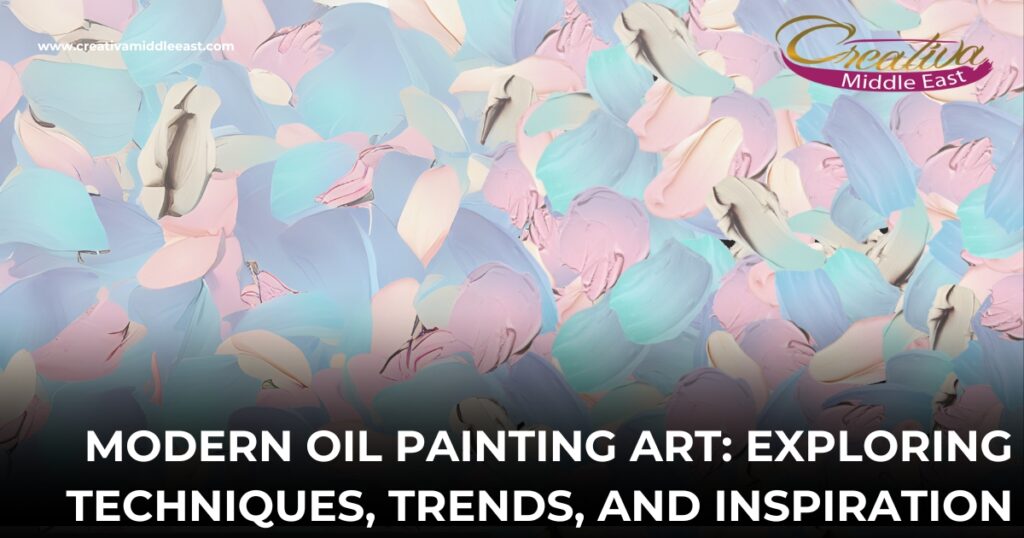
Modern oil painting art has evolved from traditional landscapes and portraits into a vibrant, diverse medium that celebrates innovation, personal expression, and experimentation. With techniques that span realism to abstract, and tools ranging from brushes to palette knives, oil painting today captivates audiences with its versatility and depth. In this blog, we’ll explore how contemporary artists approach oil painting, emerging techniques, and key trends that define this era.
1. The Evolution of Oil Painting
Historically, oil painting was used to create detailed, realistic portraits and religious scenes, with Old Masters like Rembrandt and Vermeer setting the bar for precision and depth. Modern oil painting, however, breaks these conventions. Now, artists explore new themes like self-reflection, surrealism, and social commentary, reflecting today’s rapidly changing world. The freedom of expression found in modern oil painting captures unique emotions, ideas, and stories, often experimenting with unconventional colors, textures, and compositions.
2. Popular Techniques in Modern Oil Painting
Glazing
Glazing is a classic technique where thin layers of oil paint are applied on top of one another, creating luminous effects and depth. In modern oil painting, artists often use glazing in bold, untraditional color palettes, layering hues to create vibrant yet ethereal effects that allow light to interact with the surface.
Impasto
Impasto involves applying thick layers of paint to the canvas so that brush strokes or palette knife marks are visibly raised. Artists like Van Gogh popularized this method, but modern artists take it further, creating texture-rich compositions that invite the viewer to explore the painting through both sight and touch. This tactile quality gives contemporary works a three-dimensional feel.
Alla Prima (Wet-on-Wet)
Alla Prima, or wet-on-wet painting, allows artists to complete a painting in one sitting by layering wet paint directly onto wet paint without waiting for it to dry. This technique is popular for modern artists who favor expressive strokes and dynamic energy, making it a go-to for abstract and impressionistic styles.
3. Key Trends in Modern Oil Painting
Abstract and Minimalism
Minimalism and abstract styles are highly popular in modern oil painting. Abstract artists use shape, color, and line without depicting recognizable objects, allowing viewers to interpret the work subjectively. Minimalist paintings often emphasize clean lines, muted color palettes, and negative space, creating calming, balanced compositions that reflect simplicity in a chaotic world.
Surrealism and Fantasy
Many modern artists turn to surrealist and fantasy elements, using oil painting to depict dreamlike scenes that challenge reality. Rich in symbolism and detail, these works push the boundaries of imagination, blending human figures with surreal landscapes or merging organic and synthetic forms to convey complex emotions or philosophical ideas.
Portraiture and Social Commentary
Modern oil portraits aren’t just about likeness; they’re windows into deeper human experiences and societal themes. Portraits today often convey emotions or comment on social issues, using expressionistic styles and vibrant colors. Artists may depict personal struggles, social justice issues, or cultural identity, making each piece resonate with modern viewers.
4. Modern Oil Painting Tools and Materials
The tools and materials artists use today are more varied than ever. Many artists experiment with high-quality canvas, unconventional surfaces, or even textured materials, adding new layers of creativity. Pigments have also evolved, with more eco-friendly and synthetic options available, allowing for brighter colors and greater durability. Brushes, palette knives, and even unconventional tools like sponges and scrapers are used to achieve various textures and effects.
5. Collecting and Appreciating Modern Oil Paintings
As an art collector or enthusiast, appreciating modern oil painting involves understanding the artist’s intent, technique, and how it contributes to contemporary culture. Collectors often seek pieces that speak to current social themes or showcase innovative techniques. Whether displayed in a home or gallery, modern oil paintings are valued for their originality, depth, and the unique relationship each viewer forms with the work.
6. The Future of Oil Painting
Modern oil painting continues to expand as new technologies, ideas, and cultural influences come into play. Digital tools and social media now allow artists to share and evolve their work in real time, inspiring global collaboration and new trends. Additionally, eco-conscious practices are emerging, with artists experimenting with sustainable materials, helping to push the boundaries of oil painting while protecting the planet.

